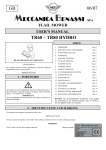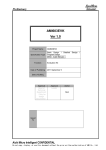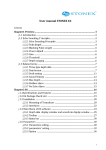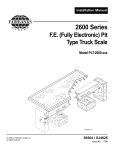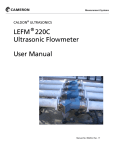Download ET – EL – ES SERIES
Transcript
INSTALLATION AND OPERATING MANUAL ELECTRONIC PLATFORMS ET – EL – ES SERIES ET-EL-ES_11.10_EN ET – EL - ES series ET-EL-ES_11.10_EN INDEX IMPORTANT WARNINGS ..................................................................................................................... 3 1 INTRODUCTION................................................................................................................................. 4 1.1 ET/EL TECHNICAL SPECIFICATIONS ........................................................................................ 4 1.2 ES TECHNICAL SPECIFICATIONS ............................................................................................. 5 2 INSTALLATION OF THE ET / EL / ES PLATFORMS ........................................................................ 5 2.1 UNPACKING THE PRODUCT ...................................................................................................... 5 2.2 INSTALLATION ON THE FLOOR AND CONNECTION OF THE PLATFORM ............................. 5 2.3 FLUSH-FLOOR INSTALLATION AND CONNECTION OF THE PLATFORM ............................... 6 3 CALIBRATION ................................................................................................................................... 7 4 MAINTENANCE AND REPAIRS ........................................................................................................ 8 4.1 TO OBTAIN THE BEST PERFORMANCE .................................................................................... 8 4.2 BREAKDOWNS AND OVERLOADS ............................................................................................ 8 5 TRANSPORTATION OF THE PLATFORM ........................................................................................ 8 6 DRAWINGS AND CONNECTION DIAGRAMS .................................................................................. 9 6.1 ET PLATFORM – FLOOR INSTALLATION................................................................................... 9 6.2 ET PLATFORM – FLUSH TO FLOOR INSTALLATION .............................................................. 10 6.3 EL PLATFORM – FLOOR INSTALLATION ................................................................................. 11 6.4 EL PLATFORM – FLUSH TO FLOOR INSTALLATION .............................................................. 12 6.5 ES PLATFORM – FLOOR INSTALLATION ................................................................................ 13 6.6 ES PLATFORM – FLUSH TO FLOOR INSTALLATION .............................................................. 15 6.7 MOUNTING FRAME FOR FLUSH FLOOR INSTALLATION OF THE PLATFORM .................... 17 7 INSTRUCTIONS FOR EQUALIZING THE ET / EL / ES PLATFORMS ............................................ 18 8 SHIELDED CABLE FOR CONNECTION OF JUNCTION BOX (JBOX) TO THE INDICATOR ....... 19 WARRANTY ........................................................................................................................................ 20 2 ET – EL - ES series ET-EL-ES_11.10_EN IMPORTANT WARNINGS Make sure the following conditions are met: - Flat, level, stable support surface isolated from vibrations, dust, and corrosive vapors. - Moderate temperature and humidity (15-30°C and 40-70%). No large air draughts. - Main power supply restricted to within + 10% ÷ - 15% of the rated voltage. - Adjust the feet of the platform until the air bubble level is centered. -Temperature and humidity moderated (do not expose to direct light of the sun, or near a source of heat). - Floor hardness of at least 100 kg/cm2. Make sure the platform is level trough the feet and the air bubble (see “INSTALLATION OF THE ET / EL / ES PLATFORMS”). Do not weld, perforate or modify the structure without consulting the reseller. If it is damaged or tampered with the warranty conditions will be annulled. If the place of use is a humid or wet environment, the installation must be carried out in such a way so that water stagnation and/or scraps under the structure are avoided. The platform must be connected to a weigh indicator using the fitted cable, following the indicator’s instructions. Do not step, crush or expose to sunlight the connecting screen cable. YOU NEED TO GROUND the metallic structure of the platform using the appropriate plug, which has this symbol , especially if you need to weigh materials that, while handled, can cause electrical discharges (dust, plastic materials, etc.). If there are any doubts, consult the reseller. DO NOT INSTALL IN HAZARDOUS ENVIRONMENTS. (unless specifically made for this use) Do not use solvents when cleaning. 3 ET – EL - ES series ET-EL-ES_11.10_EN 1 INTRODUCTION All weighing modules are built with high quality materials and are calibrated in such a way which guarantees full reliability and weighing accuracy that will lasts in time. The measuring elements are 4 load cells, produced in conformance to the OIML R60 standards. The ET/EL/ES platforms have equalized load cells, connected to each other through an IP67 junction box fitted with a 6-pole shielded cable 5 meters long used for the connection to the weight indicator. Every weighing module is built and engineered to guarantee a uniform detection of the load on the load cell weighing modules, even in adverse environment conditions. The ET, EL and ES electronic platforms are built in such a way so that they can be used in various industrial applications (simple weighing, batching, belt weighing, etc.). With a weight capacity ranging from 300 kg to 10.000 kg, they also permits a wide range of applications (see TABLE OF ET/EL/ES PLATFORM VERSIONS available at www.diniargeo.com). The platforms are built to perform efficiently in any type of environment. They are protected from a STATIC overload of over 200% of the nominal platform capacity. The ET platforms can be of two types: NORMAL Structure made of tubular steel, oven fire painted light blue RAL 5007, and removable loading top in galvanized sheet iron (also available in AISI 304 stainless steel). The measuring element consists of four shear-beam IP68 stainless steel direct load cells which are also OIML R60 approved. STAINLESS STEEL Structure and loading top in AISI 304 stainless steel. The measuring element consists of four shearbeam IP68 stainless steel load cells which are also OIML R60 approved. The EL platforms have a structure made of tubular steel and with a non-removable loading top made of sheet steel; everything is oven fire painted light blue RAL 5007. The measuring element consists of four shear-beam IP68 stainless steel load cells which are also OIML R60 approved. The ES platforms have a structure made of steel and with a non-removable loading top made of sheet steel; everything is oven fire painted light blue RAL 5007. The measuring element consists of four offcenter IP68 stainless steel load cells which are also OIML approved. 1.1 ET/EL TECHNICAL SPECIFICATIONS Load cells Max power supply tension tolerated Nominal output (nickel-plated steel cell) Combined error Compensated temperature range Operating temperature range Cell resistance: Input Output SHEAR BEAM 15 VDC 2 or 3 mV/V +/- 0,25% (depending on the model) < 0,03 % FSO -10°C / +40°C -18°C / +65°C 350 Ohm * 350 Ohm * * or 1000 Ohm depending on the model 4 ET – EL - ES series 1.2 ES TECHNICAL SPECIFICATIONS Load cells Max power supply tension tolerated Nominal output (aluminum alloy cell) Combined error Compensated temperature range Operating temperature range Cell resistance: Input Output ET-EL-ES_11.10_EN OFF-CENTER 15 VDC 2 mV/V +/- 10% < 0,03 % FSO -10°C / +40°C -10°C / +50°C 300 Ohm * 300 Ohm * * or 500 Ohm depending on the model 2 INSTALLATION OF THE ET / EL / ES PLATFORMS The weighing module must be connected to its appropriate weight indicator by using the cable coming from the junction box. The indicator, connected to the platform, can not be calibrated if not powered. It is the customer’s responsibility to prepare and calibrate the indicator. For any further detail, refer to the technical manual, supplied with the indicator. If the ET / EL / ES platform is supplied with the indicator, the calibration is not necessary; otherwise follow the instructions in the paragraph “CALIBRATION”. 2.1 UNPACKING THE PRODUCT a) Unpack the product. b) Check if any damage was caused by the transportation and make sure that there are: 1 base, 1 plate, 4 adjustable feet, 1connection cable and 1 installation manual. 2.2 INSTALLATION ON THE FLOOR AND CONNECTION OF THE PLATFORM MAKE SURE TO FOLLOW THE WARNINGS ON PAGE 3. Refer to fig.1 (paragraph 6.1), fig.3 (paragraph 6.3) or fig.5-6 (paragraph 6.5) when positioning the platform on the floor. Follow this procedure when positioning the platform: a) Screw completely the feet (2) on the cells (3) by lifting the side of the platform. NEVER UNLOOSE THE BOLTS (4). b) Level the platform by adjusting the adjustable feet (2) until the bubble (5) is in the centre of the level. The stability of the platform is very important. All the corners MUST REST IN A UNIFORM WAY. Carefully check that all feet fully rest on the ground and that the platform, loaded on the corner, is not unstable (if a corner is not resting on the ground its relative foot is easier to turn). 5 ET – EL - ES series ET-EL-ES_11.10_EN Furthermore, in order to maintain the platform performance, the feet must be adjusted in order that the height (H) of the platform corresponds to that shown in the table available at www.diniargeo.com. In no circumstance, the limits shown in the drawing below must be exceeded. K K K <0 c) Open the trapdoor on the ET platform (located on the load surface, detail 9 fig.1) or the drawer on the EL platform (located on the side of the platform, detail 9 fig.3), by removing its screws (10), and pass the screened cable connected to the junction box (detail 6, fig.1 and fig.3), through the hole (7) under the platform and connect it to the indicator. On the ES platform connect the screened cable (detail 8, fig.5) to the indicator. The cable must be free, so that the resistances are not energized, which could alter the measurement. Refer to chapter “SHIELDED CABLE FOR CONNECTION OF JUNCTION BOX (JBOX) TO THE INDICATOR” for cables color and function. d) Reposition the trapdoor on the ET platform (9 fig.1) or the drawer on the EL platform (9 fig.3) in its place (1) using its screws (10). 2.3 FLUSH-FLOOR INSTALLATION AND CONNECTION OF THE PLATFORM All the ET, EL and ES series platforms can be embedded for a flush floor use. The pit should be made with the measurements suitable to the chosen platform model according to what it is shown in the drawings available at www.diniargeo.com. For a flush to floor installation of the platform, you need to position in the pit the PIT PROFILE FRAME and the FIXING PLATES (refer to paragraph 6.2, 6.4 or 6.6, and paragraph 6.7). Dig up the pit and wall up the PROFILE FRAME as described in the drawings available at www.diniargeo.com. MAKE SURE TO FOLLOW THE WARNINGS ON PAGE 3. Refer to fig.2 (paragraph 6.2), fig.4 (paragraph 6.4) or fig.6 (paragraph 6.6) when positioning the platform on the floor. Follow this procedure when positioning the platform: a) Screw the feet (2) on the cells (3) lifting the side of the platform. NEVER UNLOOSE THE BOLTS (4). b) Install the FIXING PLATES on the angles of the pit and lower the platform. Make sure to leave a 5 mm space around the loading top (once it is repositioned), so that it will not touch the pit border 6 ET – EL - ES series ET-EL-ES_11.10_EN frame. c) Remove the plate (ET versions) or the platform (EL and ES versions) from the pit, making sure that the fixing plates are not moved. d) Tighten the fixing bolts of the plates in order to maintain the platform in the correct position. e) Open the trapdoor on the ET platform (located on the load surface, detail 9 fig.2) or the drawer on the EL platform (located on the side of the platform, detail 9 fig.4), by removing its screws (10), and pass the screened cable connected to the junction box (detail 6, fig.2 and fig.4), through the hole (7) under the platform, making it go through its piping (see drawing available at www.diniargeo.com) and connect it to the indicator. On the ES platform, pass the screened cable (detail 8, fig.7) through its piping (see drawing available at www.diniargeo.com) and connect it to the indicator. The cable must be free, so that the resistances are not energized, which could alter the measurement. Refer to chapter “SHIELDED CABLE FOR CONNECTION OF JUNCTION BOX (JBOX) TO THE INDICATOR” for cables color and function. f) Reposition the trapdoor on the ET platform (9 fig.2) or the drawer on the EL platform (9 fig.4) in its place (1) by using its screws (10). g) Reposition the platform into the pit. h) Adjust the feet (2) until the bubble (5) is in the centre of the level, making sure that the platform rests on all 4 feet. 3 CALIBRATION a) If platform and indicator are not supplied together, follow the specific instructions of the indicator to make the scale operate and then follow the steps b), c), d) and e). b) The calibration should be done 15 minutes after the indicator has been turned on. c) Calibrate the indicator by following the instructions on its technical manual. d) Check the corners (see the paragraph “INSTRUCTIONS FOR EQUALIZING THE ET / EL / ES PLATFORMS”) of the platform by positioning on these (one at a time) a weight equal to of the indicator’s maximum capacity. Check that the error is not greater than + / - 2 divisions and if this is not the case, contact the RESELLER. e) Using a reference weight, check the zero and the full-scale capacity. 7 4 MAINTENANCE AND REPAIRS 4.1 TO OBTAIN THE BEST PERFORMANCE - One should keep the platform clean. If dirt and dust accumulate on the platform one should clean it with a damp cloth or with the common cleaning products (do not use SOLVENTS and ACIDS). - Avoid platform collisions because this could cause serious damages. 4.2 BREAKDOWNS AND OVERLOADS If you think the platform is broken or damaged disconnect it in a permanent way. Do this if the platform: - appears to be damaged; - does not work; - has been loaded more than its tolerable limits (which could happen during the transportation or at time of storage). 5 TRANSPORTATION OF THE PLATFORM To pack the platform follow the procedure below: a) turn off the indicator; b) disconnect the platform’s indicator; c) remove the feet. ET – EL - ES series ET-EL-ES_11.10_EN 6 DRAWINGS AND CONNECTION DIAGRAMS Drawings available at: www.diniargeo.com 6.1 ET PLATFORM – FLOOR INSTALLATION LOAD SURFACE LOAD SURFACE SHIELDED CABLE TO INDICATOR GROUND PLUG Fig. 1 9 ET – EL - ES series ET-EL-ES_11.10_EN 6.2 ET PLATFORM – FLUSH TO FLOOR INSTALLATION ANCHOR PLATE LOAD SURFACE PIT FRAME PIT FRAME SCREENED CABLE TO THE INDICATOR Fig.2 10 ET – EL - ES series ET-EL-ES_11.10_EN 6.3 EL PLATFORM – FLOOR INSTALLATION LOAD SURFACE 1 GROUND PLUG SHIELD CABLE TO INDICATOR Fig. 3 11 ET – EL - ES series ET-EL-ES_11.10_EN 6.4 EL PLATFORM – FLUSH TO FLOOR INSTALLATION ANCHOR PLATE LOAD SURFACE 1 PIT FRAME SHIELD CABLE TO INDICATOR GROUND PLUG Fig. 4 12 ET – EL - ES series ET-EL-ES_11.10_EN 6.5 ES PLATFORM – FLOOR INSTALLATION 6 7 LOAD SURFACE 1 3 4 9 10 SHIELDED CABLE TO INDICATOR GROUND PLUG Fig.5 13 ET – EL - ES series ET-EL-ES_11.10_EN 5 Fig.6 14 ET – EL - ES series ET-EL-ES_11.10_EN 6.6 ES PLATFORM – FLUSH TO FLOOR INSTALLATION 3 LOAD SURFACE 1 4 6 7 SHIELDED CABLE TO INDICATOR GROUND PLUG Fig.7 15 ET – EL - ES series ET-EL-ES_11.10_EN 5 Fig.8 16 ET – EL - ES series ET-EL-ES_11.10_EN 6.7 MOUNTING FRAME FOR FLUSH FLOOR INSTALLATION OF THE PLATFORM POSITION 1 2 3 4 5 6 7 DESCRIPTION “L” PROFILE SECTION “L” PROFILE SECTION WITH FEET FOOT CENTERING PLATE Ǿ 10 WIDE BAND WASHER M10 SELFBLOCKING NUT Ǿ 8 WASHER M8X20 HEXAGON HEADED BOLT QUANTITY 2 2 4 8 8 8 8 WARNING AFTER HAVING MOUNTED, THE INSIDE ANGLES OF THE FRAME SHOULD BE AT 90°. IF THIS IS NOT SO MAKE SURE THAT THE INSTALLATION HAS BEEN MADE CORRECTLY AND THAT NO PARTS ARE DAMAGED. 17 ET – EL - ES series ET-EL-ES_11.10_EN 7 INSTRUCTIONS FOR EQUALIZING THE ET / EL / ES PLATFORMS 1. Make 20 turns (clockwise) of the screws of all the “T” trimmers in order to have the maximum signal on all the cells. EQUALIZATION BOARD T 2. Carry out the calibration with mass in the central point (i.e.: scale’s full scale capacity). 3. Put the indicator in visualization x 10 mode. 4. Place the sample weight (about 1/3 of the capacity) alternatively on each of the four angles of the platform “1, 2, 3, 4” and identify the cell which shows the lowest weight. ET/EL PLATFORM CELL LAY-OUT ES PLATFORM CELL LAY-OUT 3 2 3 2 4 1 4 1 LEVEL LEVEL 5. Adjust the trimmers of the remaining 3 cells so that all three display the same weight as the cell with the lowest weight; do as follows: 18 ET – EL - ES series ET-EL-ES_11.10_EN a. Position the sample weight on the angle corresponding to the cell with the greatest signal. b. Turn (counter-clockwise) the screw of the “T” trimmer of the corresponding cell until the weight equal to that of the cell with the lowest signal is displayed. c. Repeat steps “a” and “b” for the remaining two angles. 6. Check again making sure that on all four angles the same weight is displayed, otherwise adjust the trimmers of the single cells as described in points 4 and 5. 7. Once again calibrate the scale. Notes: - So that the equalization is carried out well, it is advisable to use a small-sized sample weight having a value which is about 1/3 of the capacity in order to concentrate the load on each single cell; the equalization can be considered satisfactory if the weights displayed differ of about 1 division. - In weighing systems for hazardous areas, special junction boxes may be used. The equalization described in this manual is relative to the standard junction box. 8 SHIELDED CABLE FOR CONNECTION OF JUNCTION BOX (JBOX) TO THE INDICATOR EXCITATION + SENSE + EXCITATION SENSE SIGNAL + SIGNAL EARTH BRAIDING Brown Green Grey White Pink Yellow Orange The cable that comes out from the indicator should be connected to the equalization board inside the junction box. It has 4 wires, whose meaning is described in the table: - Brown and Green wires, together on the same prod, connected to the + of the junction board. - Grey and White wires, together on the same prod, connected to the – of the junction board. In case the platform is supplied without the indicator, the end of the cable to connect to the indicator has 6 wires whose meaning is shown in the above table. 19 ET – EL - ES series ET-EL-ES_11.10_EN WARRANTY The TWO-YEARS warranty period begins on the day the indicator is delivered and covers spare parts and labour if the INSTRUMENTS are returned with prepaid shipping to the DEALER and if the breakdowns are not caused by the customer (i.e. improper use) or during the transport. If on site service is requested (or is necessary) the customer will be responsible for all of the service technician’s costs: travel time and expenses plus room and board (if any). The customer pays for the shipping costs (both ways), if the instrument is shipped to DEALER or manufacturer for repair. The WARRANTY IS VOIDED if breakdowns happen because repairs have been made by unauthorized personnel or due to connections to equipment installed by others or incorrect connection to the power supply. This warranty DOES NOT PROVIDE for any compensation for damages (indirect or direct) which may cause partial or complete failure of the instruments or systems sold, even if still in the warranty period. AUTHORIZED SERVICE CENTER STAMP 20





















